Shri Akal Takhat
Akal Takhat: Throne of the Immortal
Akal Takhat means the Throne of the Immortal. The Akal Takhat was founded by Guru Hargobind on June 15, 1606 and was established as the place from which the spiritual and temporal concerns of the Sikh community could be acted upon. It is the most supreme of all the Takhats. (There are four takhats established by the Gurus: Amritsar, Anadpur Sahib, Patna Sahib, Hazur Sahib - and a fifth Takhat at Damdamma Sahib was established later.)
The Jathedar of the Akal Takhat is the highest spokesperson of the Sikh Panth and is meant to be a spiritual leader without control or influence from any outside, politically motivated sources.
Background: The Martyrdom of Guru Arjan
Two years after the Guru Granth Sahib was installed in the Harimandir Sahib, its compiler, Guru Arjan Dev ji was arrested and tortured to death by order of the Mughal Emperor Jehangir, for harbouring the enemy’s rebel son Khusro. But, although some historians see the harbouring of Khusro as a political act, nothing in Guru Arjan Dev ji’s life supports this view. His concerns were spiritual, not political, and the murder of this man of profound learning was a senseless act. It converted a peaceful movement of reconciliation and reform into the most militant organization witnessed in India.
This tragic turning point left a deep impression on the Sikh psyche in the form of a sharp and sudden awareness of the concept of martyrdom. Out of it grew the community’s tradition of taking an implacable stand against injustice and the vagaries of tyrannical rulers. A new and lasting dimension was now added to the Sikh sense of mission and purpose.
Before his death, anticipating that the end was near, Guru Arjan Dev ji in a parting message to his son asked him to, “sit fully armed on his throne and maintain an army.” And Guru Hargobind did just that.
Guru Hargobind
Guru Hargobind acceded to the Guruship in 1606, after his father’s tragic end. Although he was just eleven years old at the time, Guru Hargobind is believed to have immediately begun the process of militarisation of the Sikh Panth. At the ceremony of ascension, the Guru declared his intentions: on his turban, he would wear the ruler’s aigrette; instead of the ascetics seli, he would wear a swordbelt with two swords symbolizing Miri and Piri, temporal and spiritual authority. Adopting traditional marks of sovereignty, Guru Hargobind asked his Sikhs to donate not cash but horses and arms. He raised a troop of 52 bodyguards, which formed the nucleus of his army. 500 youths came to him for enlistment from the Manjha (the country between the Ravi and Bias), the Doab (between the Bias and Satluj) and the Malwa countries (comprises the portion of the Punjab formed by Patiala, Nabha, Jind, Faridkot, Firzopur and Ludhiana). Guru Hargobind is also credited with developing Gatka, the martial arts of the Sikhs.
Guru Hargobind’s architectural projects, not surprisingly, reflect his agenda and his personality. On Monday, the fifth day of the light half of Har, Sambat 1663, Guru Hargobind ji laid the foundation of the Takht Akal Bunga.
The Role of the Akal Takht
The Akal Takht was built a fraction lower than the Harimandir Sahib, implying the order of importance, that the search for spiritual grace was always to lead. A similar balancing of assertion and submission was built into Guru Hargobind’s daily routine, which alternatively highlighted the shrine, with its spiritual function and self-effacing architectural symbolism, and the throne platform, with its assertion of sovereignty and temporal authority. The Guru started the day with worship in the Harimandir; he would then go on a hunt in the late morning and grant audience from the Akal Takht in the afternoon; in the evening he would return to the shrine for prayers and hymns, and at night he and his followers would return to the Akal Takht to listen to martial songs of heroic deeds.
Architecture
On the original plot of land of the Akal Takht, there only existed a high mound of earth across a wide open space, where Guru Hargobind as a child used to play. The Gurus original Takht is said to have been a simple platform, 3.5 metres high, on which the Guru would sit like a king at court, surrounded by insignia of royalty such as the parasol and the flywhisk, and perform kingly tasks of receiving petitions and administrating justice. Today’s Akal Takht is a large 5-storey modern structure with inlaid marble and a gold-leafed dome, that does not convey the design of Guru Hargobind’s simple Takht or plinth. However, recent restoration work has uncovered a layer of lime plaster, with painted decoration, that may have been part of the original Takht. That plinth was far higher than the plinth of the Harimandir; yet the absence of a superstructure kept the original Akal Takht at a level lower than the shrine.
The elaboration of the structure on marble pillars, as a semi-circular platform with an open view to the courtyard, reminiscent of an air-house, must have grown from the use to which the Durbar hall was put.
The gilding of the ceiling with ornamentations like those in the interior of the Hari Mandir is perhaps later than in the holy of holies. The wall paintings apparently belong to a later period, as there are panels showing Europeans.
The total effect of the Akal Takht is of a unique and noble structure spread out somewhat like an outer court of the piazza Saint Marco in Venice.
1984: Akal Takht Martyrdom
On June 6, 1984 military tanks stormed the Golden Temple, thousands of Sikhs were killed, and the Akal Takhat, the supreme seat of religious authority for the Sikhs martyred itself in order to awaken a sleeping spiritual nation. On the occassion of the 21th anniversary of the Akal Takhat martyrdom all Sikhs of the Guru have the blessing to remember and commemorate the Akal Takhat and all those who died in order to uphold and protect our Dharma.
Quotes about Akal Takhat
"It rightly faces the Golden Temple. Built by the Sixth Master Guru Hargobind (1606-44) in 1609, has been the nerve centre or the Sikhism ever since. All commandments affecting the community as a whole were and are issued from here. The Akal Takhat was used for holding court and Sikh congregations in the days of its builder.
The Akal Takhat was pulled down several times by the Muslim raiders. The ground floor of the present building was constructed in 1 874. Three storeys were subsequently added by Maharaja Ranjit Singh. A number of weapons used by Guru Hargobind, Guru Gobind Singh and other Sikh heroes are preserved at Akal Takhat. In 1984 during Operation Blue Star Akal Takhat was badly damaged by the Indian Army. "
- Above quote from: [www.sgpc.net]
"Akal Takhat grew into an institution which symbolized in itself the idea that the use of sword for the protection of righteousness and for self-defence was called for. Here the Guru sitting on his throne, would watch wrestling bouts and military feats of his disciples performed in the open arena opposite to the Akal Takhat. As all intricate cases and disputes were finally decided here by the Guru, the Akal Takhat served the purpose of a Supreme Court for the Sikhs. Besides throne, the Guru adopted all other emblems of royalty- the umbrella, the swords, the crest and the hawk, and thus the Sikhs called him a true king or 'Sacha Padshah'- a king in all appearance but in deeds and in purity as holy and great as previous Gurus. People looked towards Akal Takhat for guidance in their secular affairs. This custom became so significant that the decision once taken at Akal Takhat was followed by the Sikhs enthusiastically and this was the reason that they were always able to overcome every peril. The development of this custom contributed a lot towards the consolidation of the Sikh Movement."
- Above quote from: [www.allaboutsikhs.com]
"[In] 1920 Sri Akal Takhat came under Panthic control of Shiromani Gurudwara Prabandhak Committee. Bhai Teja Singh of Bhuchar made a suddden swoop on the Akal Takhat and took possesion of the shrine.
==> AKAL TAKHAT - an institution, initially named Akal Bunga, established by Sri Guru Hargobind Sahib in sunmat 1665 for Sikh Governance, located in front of Harmindar Sahib, Amritsar. Regular diwans were conducted daily, during early morning and evening by Guru Sahib. AkalBunga, represents the centre for all Panthic jathaebandia (groups). It is where Gurmat resolutions are announced and procalamations made that are binding to all Sikhs around the world. Akal Bunga is the first Takhat for Sikhs and hence popularly known as Akal Takhat. Some of the arms preserved at this location include:
- 1. Sri Sahibs (swords) of Guru Hargobind Sahib that represented Miri and Piri
- 2. Sri Sahib (sword) of Guru Gobind Singh Ji
- 3. Sri Sahib (sword) of Baba Buddha Ji
- 4. Sri Sahib (sword) of Bhai Jaetha Ji
- 5. Sri Sahib Baba Karam Singh Ji Shaheed
- 6. Sri Sahib Bhai Uday Singh Ji, who was with Guru Gobind Singh Ji
- 7. Sri Sahib Bhai Bidhi Chand Ji
- 8. Dudhara Khanda (double-edged sword) of Baba Gurbakash Singh Ji Shaheed
- 9. Dudhara Khanda (double-edged sword) of Baba Deep Singh Ji
- 10. Dudhara Khanda of Baba Nodh Singh Ji Shaheed
- 11. Khadag Bhai Vachitar Singh Ji which weighed 10 Saer
- 12. Guru Hargobinds Sahib's "Guraj" weighing 16 saer. It was given to Dharamvir Jassa Singh by Matta Sundari
- 13. A sword like weapon belonging to Guru Hargobind Sahib Guru Hargobind Sahib's Katar
- 14. Baba Ajit Singh's Katar
- 15. Baba Jujhar Singh's Katar
- 16. Guru Hargobind Sahib's kirpan
- 17. Guru Hargobind's Paeshkabaj
- 18. Baba Deep Singh's Paeshkabaj
- 19. A sword like weapon of Baba Deep Singh Ji Shaheed
- 20. Pistol of Baba Deep Singh Ji Shaheed
- 21. Two arrows of Guru Gobind Singh each cxontaining one Toala of gold
- 22. Medium sized Khanda of Baba Deep Singh Ji
- 23. Two kirpans of Baba Deep Singh Ji
- 24. Two small Khandas of Baba Deep Singh Ji
- 25. Chakar Of Baba Deep Singh Ji
- 26. Small Chakar of Baba Deep Singh Ji
- 27. Baba Deep Singh Ji's chakar for head decoration
-Ref. Mahan Kosh (pp. 36)
- Above quote from: [www.allaboutsikhs.com]
References
- Singh, Patwant (1989). The Golden Temple. South Asia Books. ISBN 9627375012.
- edited by Kavita Singh (2003). New Insights into Sikh Art. Marg Publications. ISBN 8185026602.
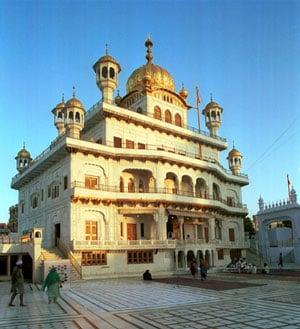
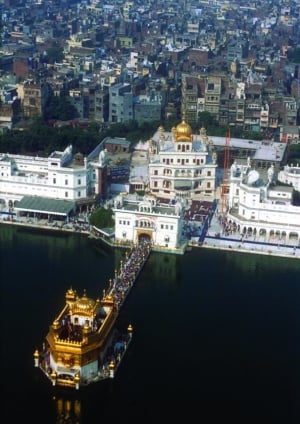
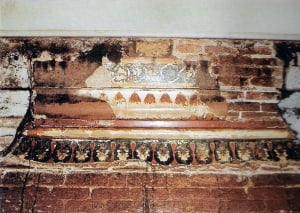
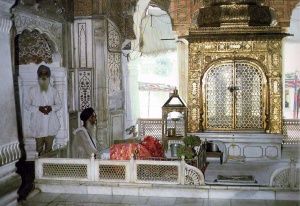
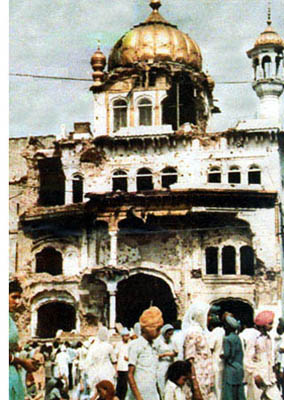
![]](/images/thumb/8/8c/Img0004.jpg/200px-Img0004.jpg)
